I was doing some research this weekend, as authors constantly do. I needed to be in Paris, so I Google Mapped myself there.
As I was virtually walking down various streets, I came across the Rue de Rivoli. It caught my eye because I was in Paris in April 2016 and walked down that street. I giggled at the time. It reminded me of ravioli, and I thought how funny it was to have a Ravioli Street in Paris.
Then I remembered my actual walk down that street. I traveled it multiple times, as it borders some of the typical areas a tourist would visit. My first stroll down the rue was when I went to the Louvre, discovered it was closed on Tuesdays (why Tuesday?) so I couldn’t visit.
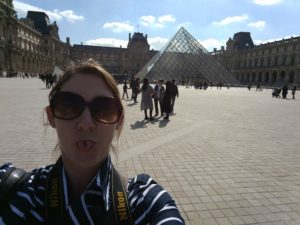
Me, upon discovery that the Louvre was closed.
It was the best thing that could have happened. Instead, I wandered through the Jardin des Tuileries, then over the Seine by way of the Passerelle Léopold Sédar Senghor footbridge, with its lovers’ locks clasped onto the railings.
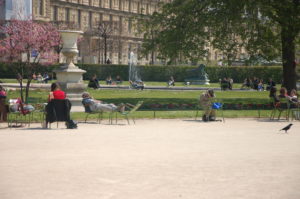
Gentleman napping in the gardens.
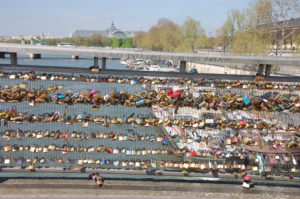
Lover’s locks
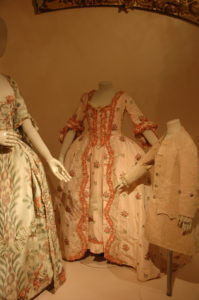
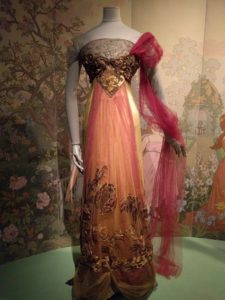
During my second walk down the Rue de Rivoli, I was headed toward a fashion exhibit at the Musée des Arts Decoratifs. The museum is in the same building as the Louvre, though you can reach it from a separate entrance. The exhibit celebrated clothing from 1700 to the present day, and of course, I couldn’t resist.
But then I remembered something more from that day.
I was headed more or less west along the side of the building that houses the museums. Basically, from the back to the front, where you can enter the courtyard and see the huge glass pyramid.
Along that long, decorative wall of the old palace were tall windows, the rooms beyond hidden by curtains. In between, at odd intervals, were huge, ornate double doors.
And when I say huge, I mean huge. If you walk down the road using the map above, you will see the doors on your left, and the little tiny people in front of them.
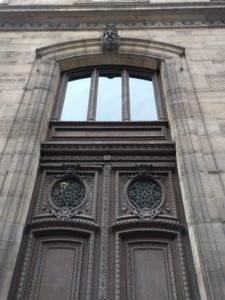
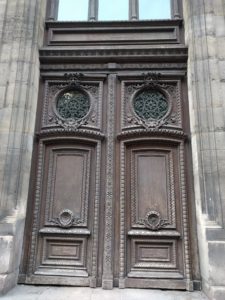
For some reason, I loved the doors. I did not know where they lead to, but I could see soldiers spilling out in defense when the building was first a fortress, or later, those doors being thrown wide open for a ball during the days of the kings. Even guards during the French Revolution, when it first became a museum to display national treasures.
I remember I stopped walking and stared at those beautiful doors. Imagining. Dreaming.
A Frenchwoman—gorgeous, confident, and with heeled boots I would have killed for—continued to clip past me as I stood there. Dangling from her hand was a shopping bag, the square paper type you would find at a clothing store. She had an amazing leather jacket, neat and trim, over skin tight jeans, and long brown hair that reached nearly to her waist. In other words, I felt very much the silly American tourist in my sneakers and striped coat from Old Navy beside that lovely woman.
Still, as she passed, I pulled out my digital Nikon and snapped a picture of the doors. I was fascinated by their size, by the ornate face carved above and the designs embedded in them. Each dip and curve and exquisite carving was something out of the past that simply does not exist today. This is workmanship of the most delicate, intricate, talented kind. Created by artisans long forgotten, and probably not even fully appreciated at the time.
So many changes since then, I mused. The world is not the same. Art is not the same. This timeless, gorgeous piece of work sits here on the edge of a busy road, and no one sees it. Residents and tourists walk by, day after day, with their shopping bags or their briefcases or their cameras, and so many never notice the utter beauty, the history, right there beside them.
It made me sad to realize it. To know that the people who pass these doors everyday, or even tourists ready for a new experience, don’t actually see it.
I turned away, tucked my camera back in my bag, and continued toward the museum. A little heavier of heart.
Then I stopped again. Because the gorgeous woman with the high-heeled boots and the shopping bag was standing in front of the next set of doors. I remember specifically the way her head tipped back, because of the lovely fall of thick, straight, brown hair. Me and my thin, chin length bob were totes jelly.
She was looking at the doors. Not snapping a picture with her phone, not talking to anyone. She was just looking.
Was she seeing them for the first time, having passed by a hundred times before? Did she notice me, the silly tourist snapping a picture of the first door, and did it make her wonder about the next one? Does she understand the rich, wonderful history of her culture and country can be defined by that very door?
I do believe that if I had not stopped to study and imagine and dream at the first set of doors, she would not have stopped to look at the second set. And if she paused to look, she likely had never noticed the doors before.
Perhaps, with my small moment of wondering and dreaming, I was able to help someone see beauty that lives only a few steps away from their daily life.
And perhaps, by watching her, I learned to see the beauty that lives only a few steps away from my own life.
What a lovely thing to share. I would be enamored with the doors, too.
Thank you, Denise! The doors were so amazing, set in the beautiful building. At least twice my height, and with such lovely designs. A small thing, perhaps, compared to Notre Dame or the Eiffel Tower, but just as amazing. More so, perhaps, because they were just there, on a busy thoroughfare.
Europe has such lovely old doors. A friend visited several other countries and posted pics of ornate doors. We don’t have that here. Old buildings are torn down to make way for sterile high-rises or shopping malls. Such a shame. How wonderful you were able to “walk” down the rue via Google. I’ve never tried that. Great idea.
My phone is filled with pics of doors, doorknockers, doorknobs across Europe. A simple portal can be a work of art! Love that you had that experience.